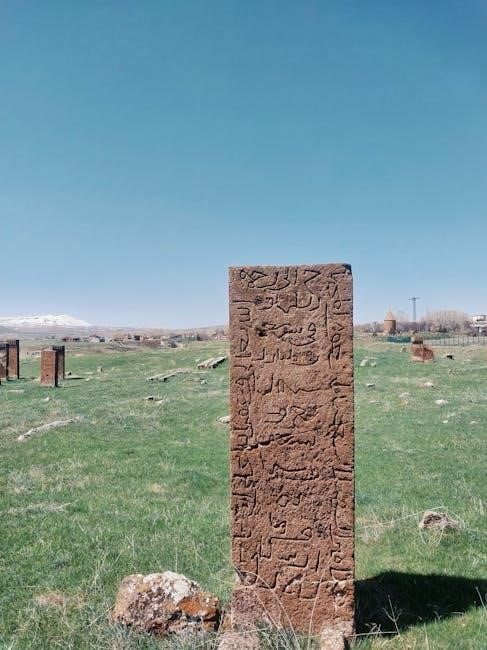Chopin’s Waltz in A Minor, B.150, is a beloved piece among pianists, offering a delicate balance of emotion and technique. Its availability in free PDF formats makes it accessible to musicians worldwide, with versions suitable for intermediate players. This waltz, published posthumously, remains a testament to Chopin’s mastery of expressive piano music.

Overview of the Waltz in A Minor
Chopin’s Waltz in A Minor, B.150, is a captivating piece known for its emotional depth and technical balance. Composed during Chopin’s later years, it was published posthumously, showcasing his enduring influence. The waltz is structured in a traditional 3/4 time signature, with a key of A minor and an Allegretto tempo, creating a somber yet graceful atmosphere. Its flowing melodies and rhythmic patterns highlight Chopin’s mastery of expressive piano music. Available in both 1-page and 2-page PDF versions, the sheet music is accessible to intermediate pianists, offering a rewarding experience. This waltz remains a popular choice for its beauty and interpretive possibilities.
Significance of the Waltz in A Minor in Chopin’s Repertoire
Chopin’s Waltz in A Minor holds a unique place in his repertoire as a posthumously published work, reflecting his late compositional style. It exemplifies his ability to blend technical intricacy with emotional simplicity, making it accessible to intermediate pianists while maintaining its artistic depth. The waltz is notable for its melodic elegance and harmonic richness, typical of Chopin’s romantic era contributions. Its popularity endures due to its expressive qualities and the availability of free PDF sheet music, allowing pianists to explore and interpret this cherished piece. It stands as a timeless testament to Chopin’s enduring legacy in piano music.

Composition and Publication Details
Composed in 1830, Chopin’s Waltz in A Minor was published posthumously as B.150, offering a glimpse into his evolving style. Available as free PDF sheet music.
Composition History and Background
Chopin’s Waltz in A Minor, B.150, was composed in 1830, reflecting his early experimentation with waltz forms. The piece, though lesser-known during his lifetime, was published posthumously, showcasing his unique harmonic and rhythmic innovations. Its structure, while adhering to traditional waltz conventions, introduces intricate melodic lines and emotional depth. The waltz is notable for its Allegretto tempo and A minor key, creating a somber yet graceful atmosphere. Despite its technical demands, the piece remains accessible, particularly through free PDF downloads, making it a favorite among intermediate pianists seeking to explore Chopin’s expressive repertoire.
Publication and Catalogue Information (B.150)
Chopin’s Waltz in A Minor, B.150, was published posthumously by Julius Fontana in 1851. It is part of the Brown Index catalogue, which categorizes Chopin’s works chronologically. The piece was not widely recognized during Chopin’s lifetime but gained popularity after its publication. The B.150 designation helps music enthusiasts and scholars identify the work within Chopin’s extensive repertoire. Today, the Waltz in A Minor is readily available in PDF formats, making it accessible to pianists worldwide. Its publication history reflects the enduring legacy of Chopin’s compositions, ensuring his music remains a cornerstone of classical piano literature.
Musical Structure and Analysis
Chopin’s Waltz in A Minor, B.150, is structured in a traditional waltz form, featuring a 3/4 time signature and an Allegretto tempo. Its expressive melodies and nuanced harmonies create a rich, emotional experience, characteristic of Chopin’s compositional style.
Musical Key and Tempo (A Minor, Allegretto)
Chopin’s Waltz in A Minor, B.150, is written in the key of A minor, which gives it a somber yet elegant character. The tempo marking is Allegretto, indicating a moderate pace that allows for expressive phrasing.
The choice of A minor simplifies the key signature, avoiding sharps or flats, making it accessible for intermediate pianists. The Allegretto tempo provides a graceful flow, enhancing the waltz’s lyrical qualities. This combination of key and tempo creates a piece that is both technically manageable and emotionally rich, reflecting Chopin’s mastery of blending simplicity with depth in his compositions.
Time Signature and Rhythmic Patterns (3/4 Time)
Chopin’s Waltz in A Minor is written in a 3/4 time signature, a common meter for waltzes, which emphasizes the dance-like triple rhythm. The piece features rhythmic patterns that include arpeggios, grace notes, and subtle syncopations, adding complexity while maintaining a graceful flow.
The 3/4 time signature creates a clear waltz feel, with one strong beat followed by two weaker beats. This structure allows for expressive phrasing and dynamic contrasts, such as crescendos and decrescendos, which are characteristic of Chopin’s style. The rhythms are intricate yet accessible, making the piece both challenging and rewarding for intermediate pianists to master.

Sheet Music and PDF Availability
Chopin’s Waltz in A Minor is widely available as free PDF downloads from platforms like Musopen.org and PianoCoda.com, offering both 1-page and 2-page versions for convenience.
Free PDF Downloads and Sources
Chopin’s Waltz in A Minor is readily available for free download in PDF format from various reputable sources. Platforms like Musopen.org and PianoCoda.com offer high-quality scores, with options for both 1-page and 2-page versions. Additionally, sites such as 8notes.com and the International Music Score Library Project (IMSLP) provide free access to the sheet music, ensuring accessibility for pianists worldwide. These sources often include additional features like MIDI files or MP3 recordings, aiding in practice and performance preparation. The piece is graded at a Grade 6 level, making it suitable for intermediate players seeking to expand their repertoire.
Version Variations (1 Page vs. 2 Page Versions)

The Waltz in A Minor is available in two convenient versions: a 1-page and a 2-page layout. The 1-page version is ideal for performers who prefer a compact format, reducing page turns during practice or performance. This version maintains the original composition’s integrity without sacrificing readability. Alternatively, the 2-page version offers a more spacious layout, making it easier for pianists to follow complex passages and nuances in the music. Both versions are available for free download in PDF format from sources like Musopen.org and PianoCoda.com, catering to different preferences and needs of pianists.

Performance and Practice Tips
Focus on dynamics and phrasing to capture the emotional depth. Practice with a metronome to maintain the Allegretto tempo. Start slowly to refine finger dexterity and control.
Level of Difficulty and Accessibility
Chopin’s Waltz in A Minor is considered an intermediate-level piece, suitable for pianists with some technical proficiency. Its Grade 6 level makes it accessible to those familiar with Chopin’s style. The piece requires precise finger dexterity, especially in the right-hand melody, and a strong sense of rhythm to maintain the 3/4 waltz time. While it presents challenges, such as nuanced dynamics and ornaments, its structure is manageable for dedicated students; The availability of free PDF sheet music in both one and two-page versions allows for ease of practice and performance, making it a popular choice among pianists seeking to expand their repertoire.
Practice Recommendations for Intermediate Pianists
Intermediate pianists approaching Chopin’s Waltz in A Minor should begin by mastering the right-hand melody, focusing on dynamics and phrasing. Practice the left-hand accompaniment separately, ensuring a steady waltz rhythm in 3/4 time. Pay attention to ornaments and mordents, which require precise finger control. Start at a slower tempo to build confidence and gradually increase speed. Emphasize balance between hands, allowing the melody to sing while maintaining a subtle accompaniment. Regular practice of small sections will help refine tricky passages. Use free PDF resources to access the score and guide your practice effectively.

Historical Context and Reception
Composed during Chopin’s lifetime, the Waltz in A Minor was published posthumously, gaining popularity for its expressive, accessible nature, making it a favorite among pianists and audiences alike.
Chopin’s Approach to Waltz Composition
Chopin’s waltzes, including the Waltz in A Minor, showcase his mastery of blending lyrical melodies with intricate harmonies and rhythms. His approach often featured a clear structural form, typically following an ABA pattern, with an exposition, development, and recapitulation. The Waltz in A Minor exemplifies this, with its somber, introspective mood conveyed through the minor key. Chopin’s use of ornamentation and nuanced dynamics adds emotional depth, while maintaining a balance between technical complexity and melodic simplicity. This piece demonstrates Chopin’s ability to create music that is both accessible to intermediate pianists and rich in artistic expression, making it a timeless favorite in his repertoire.

Impact and Popularity of the Waltz in A Minor
Chopin’s Waltz in A Minor has become a beloved piece in classical piano repertoire, celebrated for its emotional depth and technical accessibility. Its melancholic yet elegant melody resonates with listeners, making it a favorite among audiences and pianists alike. The piece’s popularity is further evident in its widespread availability as free PDF downloads, catering to both intermediate and advanced players. Its timeless appeal lies in its ability to evoke a range of emotions while maintaining a delicate balance between simplicity and complexity. This waltz continues to inspire new generations of musicians and music enthusiasts, solidifying its place as one of Chopin’s most cherished works.
Additional Resources and Recordings
Explore additional resources and recordings of Chopin’s Waltz in A Minor on platforms like PianoCoda.com and Musopen.org, offering high-quality sheet music and audio interpretations for deeper appreciation.
Online Platforms for Sheet Music and Recordings

Several online platforms offer free and high-quality resources for Chopin’s Waltz in A Minor. PianoCoda.com provides free PDF downloads and MIDI files, while Musopen.org offers both PDF sheet music and MP3 recordings without copyright restrictions. Additionally, 8notes.com features free sheet music for piano, making it accessible to musicians worldwide. These platforms cater to pianists of all levels, ensuring that Chopin’s masterpiece remains widely available and easily accessible for practice, performance, and enjoyment. They also often include practice tools and recordings to aid in mastering the piece.
Recommended Arrangements and Interpretations
Chopin’s Waltz in A Minor is available in various arrangements, with solo piano versions being the most popular. Arrangements by Quentin Talon and DimitrisG1 are highly recommended for their fidelity to Chopin’s original composition. These adaptations maintain the piece’s emotional depth and technical nuances, making them ideal for intermediate pianists. Additionally, platforms like Musopen.org and PianoCoda.com offer high-quality recordings and interpretations that showcase the waltz’s expressive qualities. These resources provide valuable insights for musicians aiming to master the piece, offering both inspiration and practical guidance for performance.
Chopin’s Waltz in A Minor is a captivating piece, offering a unique blend of simplicity and depth. Its accessibility makes it a great choice for pianists exploring Chopin’s works.
Final Thoughts on Chopin’s Waltz in A Minor
Chopin’s Waltz in A Minor, B.150, stands as a cherished composition, bridging simplicity with emotional depth. Its posthumous publication underscores its timeless appeal, making it accessible to pianists of various levels. The piece’s Grade 6 level ensures it is approachable for intermediates, while its intricate nuances challenge more advanced players. Free PDF downloads and multiple versions cater to diverse preferences, allowing pianists to explore and interpret the waltz in ways that resonate personally. This waltz not only highlights Chopin’s compositional brilliance but also serves as a gateway to his broader repertoire, inviting musicians to delve into his expressive and technically rewarding works.
